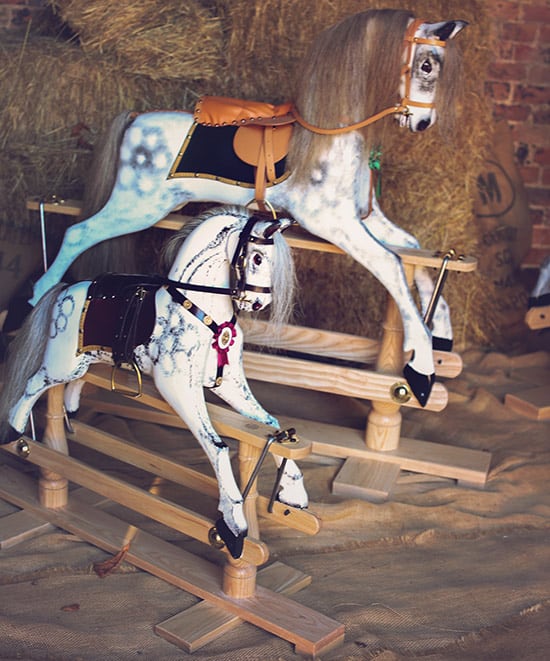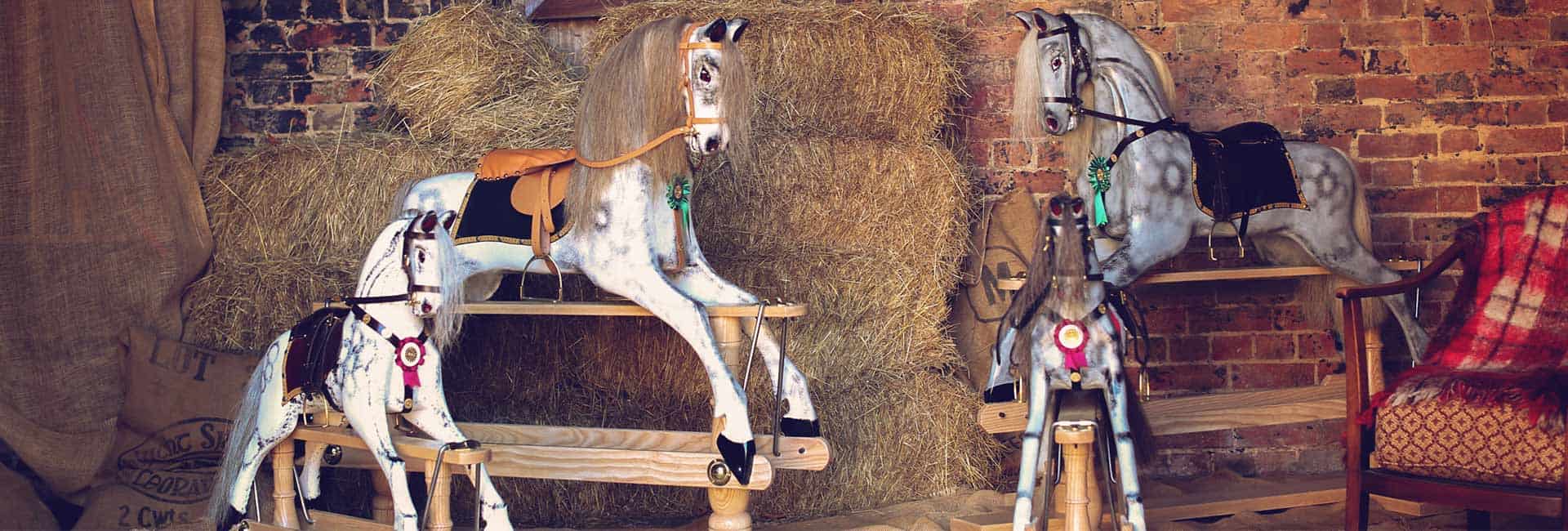Blog
A history of the English Dapple Grey Rocking Horse
4 February 2021
The first known rocking horses were made very simply from two semi-circular pieces of wood. These parts were joined, leaning in to each other and held together by a third crosspiece which enables the rocking action.
Pull-along wheeled horses stretch back to the time of the Pharaohs in Egypt. Gradually the crosspiece was enlarged and embellished to make these horses resemble real horses more and more. These rocking horses are called board-sided rocking horses and they are the precursors to the rocking horses that are so familiar to us today.
It is somewhat surprising that the earliest surviving board horses hail from the 17th Century, especially when we have evidence of wooden horses associated with play back to the Egyptian period of 500 or so BC. This together with the custom of making rocking cradles for infants to sleep makes it intriguing to know why the rocking horse as a toy was not developed until the 17th Century. It’s also interesting that the rocking horse is not a traditional toy elsewhere in Asia. Infants are traditionally carried either at the hip of an adult or in a sling until they are able to walk in much of the continent, so perhaps the development of the cradle and the rocking horse are linked. Either way, both devices are designed to comfort and soothe the child. When one adds to this the fact that early cradles resemble board horses in their design, we may be forgiven for making a leap of judgement here.

Board-sided rocking horses gradually became more and more elaborate and were decorated by carving and painting them to look more like real horses as time went by. The first horse that is recognisable on rockers rather than half-moon boards is called “Lord Grantley’s Rocking Horse”. This was a large magnificently carved horse mounted on two bow rockers. It is so named because it has been passed down through the Grantley family for generations — though it is believed by historian Gwen White that the horse originally belonged to the last male child of another family: the Chapples at Wonersh Park in Surrey, England. The owner died in 1730, according to White.
What is now thought of as the “traditional dapple grey rocking horse” was a creation particular to the English manufacturers of the nineteenth century. The dapples — which are applied by hand using a stippling brush or similar, short haired applicator — seem to be a development of earlier black and white spotted markings on toy horses. This pattern became by far the most popular pattern between the mid-nineteenth century and World War I. The popularity of this pattern spread to the pull-along horses and the little cart-horses which were also very popular at that time.
Nobody knows which manufacturer was the first to adopt this pattern, but one family has an oral history suggesting that they were at least early adopters of the pattern. Walter Lines, speaking about his father’s firm of G&G Lines, claimed that the horses were based on that seen in a painting called “The Horse Fair” by Bonheur and Micas around 1853-1855. It is highly likely that this painting or another will have been the inspiration for the pattern as it is purely a stylistic decoration. After all, real horses do not look exactly like Dapple Grey rocking horses. The purpose of the decoration is to add to the impression of reality, to make it more life-like and give it some ‘movement’.
Early in the century King George IV inspired a fashion for grey horses and, in his stud, he bred high class grey stallions (Karl Grober, 1932). So perhaps the royal patronage had an effect on popularity as brown and black horses were up until this time considered to be more thoroughbred. In the nineteenth century riding had become a pleasant pastime for the well-to-do classes, and the activity was taken very seriously. Great attention was placed on the smart turn-out of the horse and rider, and there were many popular riding routes for early morning exercise for the horses.
Often in Victorian times every member of the household would own a horse, and so it was important for the youngsters to learn early. This obsession extended itself into the children’s nurseries, and so rocking horses became de-rigueur in the middle-class home. Dapple Greys dominated this market, apart from the very top end of the scale where G&G Lines and FH Ayres supplied skin-covered horses to the aristocracy. These high-end horses were no doubt inspired by the European manufacturers which I will briefly cover in another blog.
The manufacture of these horses continued in large numbers throughout the interwar period. But a great number of family-run rocking horse businesses ceased to trade at the beginning of World War II, so from 1940 onwards the production of these beautiful toys went into steep decline. One or two manufacturers such as the Collinson family managed to continue until the 1980’s. But by this time, the craft was in need of a new revival, which rocking horse maker Anthony Dew sparked and nurtured through his work and writings.
Dapple Grey horses will have been finished in about the same manner as they are today (certainly at Mr Hignett’s Horses). After the body is assembled and carved it is rough sanded and given one or two coats of size (either a dilute preparation of rabbit skin glue or diluted PVA glue), then a further five or six coats of gesso (glue and gilders’ whiting). This is allowed to dry for a couple of weeks before it is sanded smooth. Then, the dappling is applied by hand with a stippling brush, so no two horses are identical. The horse is then finished with two or three coats of varnish. Nowadays we use an acrylic varnish but the family used to use a “Spirit Varnish,”; a brand which is no longer available. Older varnishes like Spirit did yellow with age — something which is not a problem with modern acrylic varnishes.

